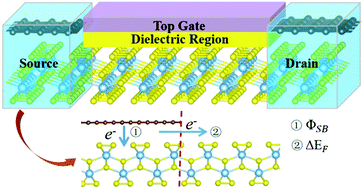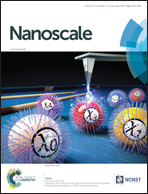TiS3 sheet based van der Waals heterostructures with a tunable Schottky barrier†
Abstract
Monolayer titanium trisulfide (TiS3), synthesized recently through exfoliation [Adv. Mater., 2015, 27, 2595], has emerged as a new 2D material with outstanding electronic and optical properties. Here, using first-principles calculations we show for the first time the great potential of the TiS3 monolayer as a channel material when in contact with graphene and other 2D metallic materials to form van der Waals (vdW) heterostructures, where the intrinsic properties of both the TiS3 monolayer and the 2D materials are preserved, different from the conventional 3D metal/TiS3 semiconductor heterojunction [Nanoscale, 2017, 9, 2068]. Moreover, the TiS3 monolayer forms an n-type Schottky barrier (Φe) when in contact with graphene, exhibiting a tunneling barrier and a negative band bending at the lateral interface; the Schottky barrier character can also be changed from n-type to p-type by doping graphene with boron atoms or replacing graphene with other high-work-function 2D metals, while a Schottky-barrier-free contact can be realized by doping graphene with nitrogen atoms, thus providing a solution to the contact-resistance problem in 2D electronics.

- This article is part of the themed collection: Editor’s Choice: van der Waals heterostructures


 Please wait while we load your content...
Please wait while we load your content...